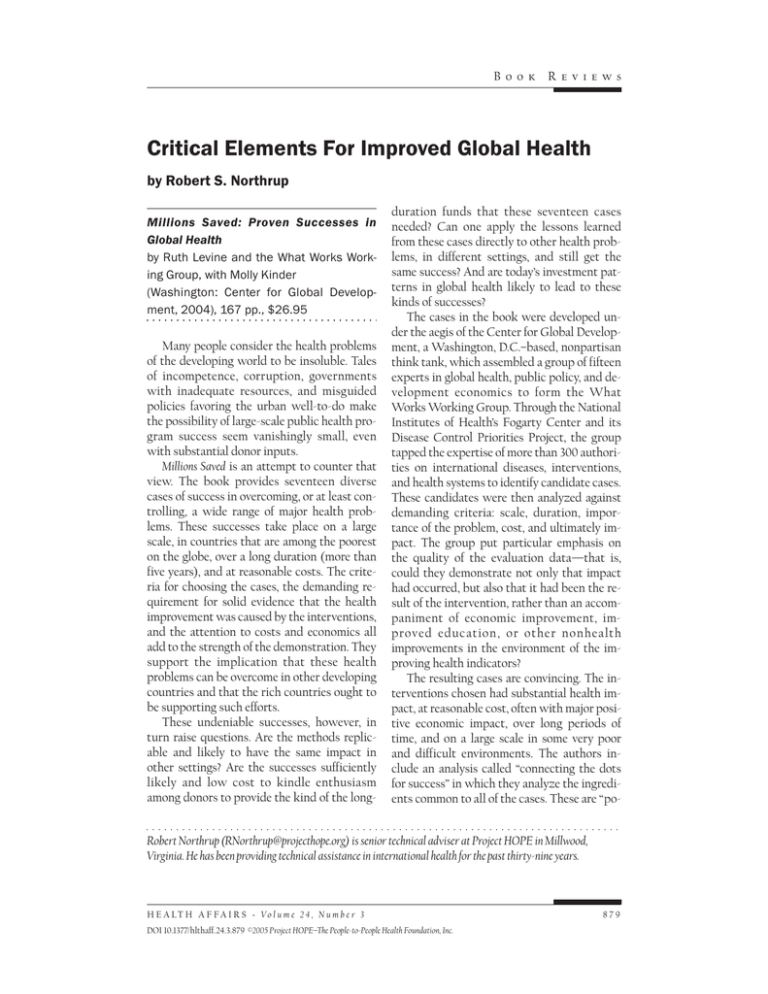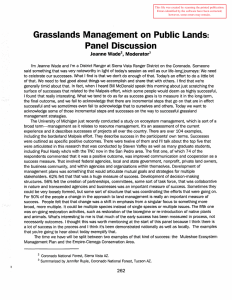Critical Elements For Improved Global Health by Robert S. Northrup
advertisement

B o o k R e v i e ws Critical Elements For Improved Global Health by Robert S. Northrup Millions Saved: Proven Successes in Global Health by Ruth Levine and the What Works Working Group, with Molly Kinder (Washington: Center for Global Development, 2004), 167 pp., $26.95 Many people consider the health problems of the developing world to be insoluble. Tales of incompetence, corruption, governments with inadequate resources, and misguided policies favoring the urban well-to-do make the possibility of large-scale public health program success seem vanishingly small, even with substantial donor inputs. Millions Saved is an attempt to counter that view. The book provides seventeen diverse cases of success in overcoming, or at least controlling, a wide range of major health problems. These successes take place on a large scale, in countries that are among the poorest on the globe, over a long duration (more than five years), and at reasonable costs. The criteria for choosing the cases, the demanding requirement for solid evidence that the health improvement was caused by the interventions, and the attention to costs and economics all add to the strength of the demonstration. They support the implication that these health problems can be overcome in other developing countries and that the rich countries ought to be supporting such efforts. These undeniable successes, however, in turn raise questions. Are the methods replicable and likely to have the same impact in other settings? Are the successes sufficiently likely and low cost to kindle enthusiasm among donors to provide the kind of the long- duration funds that these seventeen cases needed? Can one apply the lessons learned from these cases directly to other health problems, in different settings, and still get the same success? And are today’s investment patterns in global health likely to lead to these kinds of successes? The cases in the book were developed under the aegis of the Center for Global Development, a Washington, D.C.–based, nonpartisan think tank, which assembled a group of fifteen experts in global health, public policy, and development economics to form the What Works Working Group. Through the National Institutes of Health’s Fogarty Center and its Disease Control Priorities Project, the group tapped the expertise of more than 300 authorities on international diseases, interventions, and health systems to identify candidate cases. These candidates were then analyzed against demanding criteria: scale, duration, importance of the problem, cost, and ultimately impact. The group put particular emphasis on the quality of the evaluation data—that is, could they demonstrate not only that impact had occurred, but also that it had been the result of the intervention, rather than an accompaniment of economic improvement, improved education, or other nonhealth improvements in the environment of the improving health indicators? The resulting cases are convincing. The interventions chosen had substantial health impact, at reasonable cost, often with major positive economic impact, over long periods of time, and on a large scale in some very poor and difficult environments. The authors include an analysis called “connecting the dots for success” in which they analyze the ingredients common to all of the cases. These are “po- Robert Northrup (RNorthrup@projecthope.org) is senior technical adviser at Project HOPE in Millwood, Virginia. He has been providing technical assistance in international health for the past thirty-nine years. H E A L T H A F F A I R S ~ Vo l u m e 2 4 , N u m b e r 3 DOI 10.1377/hlthaff.24.3.879 ©2005 Project HOPE–The People-to-People Health Foundation, Inc. 879 B o o k R e v i e ws litical leadership and champions, technological leadership and innovation, expert consensus around the approach, management that effectively uses information, and sufficient financial resources.” The implication is that these kinds of successes are there for the taking, that we have learned how to do it, and that we should go out and do likewise elsewhere. I don’t believe that this is the case. In fact, neither do the authors. They cite a half-dozen “wows”—conclusions apparently surprising even to them: (1) Success is possible even in very poor countries; (2) local governments can do the job and at times can even pay the cost; (3) bringing about behavior change is the most fundamental element in addition to technology; (4) international coalitions and partnerships can be critical, particularly for regional and global efforts; (5) attribution of measured outcomes and impact to the interventions is possible (although often not available because of cost); and (6) successes are not always the result of vertical programs and campaigns such as polio eradication. But the fact that these “wows” are surprising is itself good evidence that successes such as these are not readily attained. For example, regarding the first two “wows,” very poor countries typically make only minute per capita investments in health. This leads to all kinds of lacks: lack of personnel to pay effective attention to a particular problem, lack of vehicles to put supervisors into communities to work with outreach workers and community volunteers, lack of an information system to provide managers with the means to improve performance, and lack of skills and experience among the available workforce. Also, the private sector is often a major part of developing countries’ health systems, but health ministries often have little interest or skills in using and effectively influencing the private sector to accomplish public health goals. Regarding vertical programs and campaigns, although they are not essential, donors tend to prefer targeted investments, narrow and clearly defined outcomes, and structured programs and projects. Such efforts lend themselves to clear contracts with implementers 880 and give the expectation (some might say illusion) of predictable results. In poor countries’ donor environment, the broad support needed to improve the service delivery system as a whole is often lacking. Systems with structural and functional deficiencies not only do poorly at providing general health care but often are unable to support targeted vertical programs. Working in West Africa on a USAID-funded diarrhea technical assistance project, we found that we often had to take action to improve the general supply logistics to get oral rehydration supplies available dependably at peripheral health posts and centers and to improve other general system functions. Oral rehydration fluid turned out not to be the “simple solution” to diarrhea we had naïvely thought it to be! Perhaps the most important factor in improving global health is information for management of performance. The hand and paper systems that dominate many health ministries in poor countries produce data slowly or not at all. Even when information is available rapidly, managers are not accustomed to using it to identify and solve performance problems. The programs represented in Saving Millions had to have effective information and management systems; they had to be actively using monitoring and evaluation data in improving performance at all levels to get the results we read about here. This same information was critical as well for documenting impact and using those data to market the program’s activities to government decisionmakers and private donors. But such effective information systems are the exception. Overcoming these challenges is possible, as these cases demonstrate, but could hardly be considered customary. Clearly, long-term investments by private-sector donors and governments are needed, so that efforts to improve support systems and targeted vertical programs and projects may proceed. Donors want to do the right thing. Perhaps this wellargued book will help encourage them to invest in health and also to include in those investments the range of critical elements needed for success. May/ June 2005





